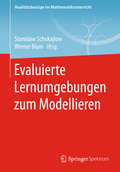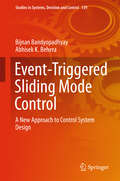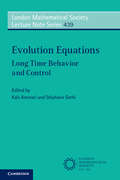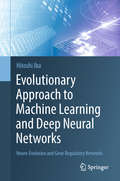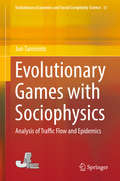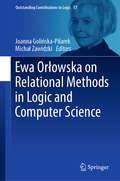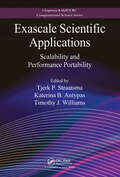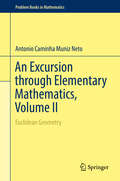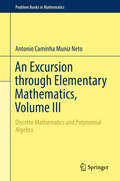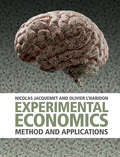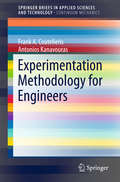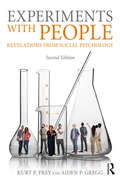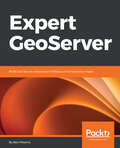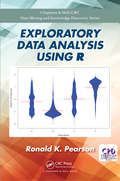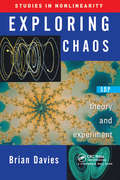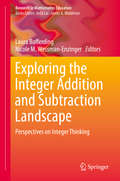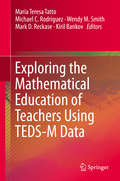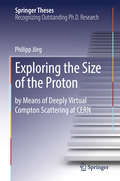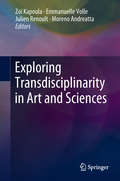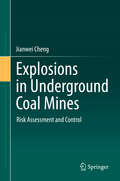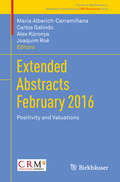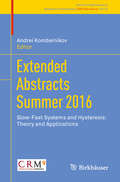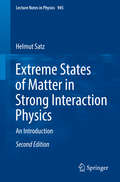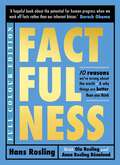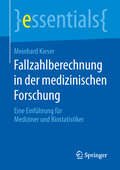- Table View
- List View
Evaluierte Lernumgebungen zum Modellieren (Realitätsbezüge Im Mathematikunterricht Ser.)
by Stanislaw Schukajlow Werner BlumDas Buch stellt empirisch gesicherte Erkenntnisse über Lernumgebungen im Bereich Modellieren vor. Dabei wird den Bestrebungen nach mehr Wissenschaftlichkeit einerseits und einer hinreichend ausführlichen Beschreibung der untersuchten Lernumgebungen andererseits Rechnung getragen. Die vorgestellten Ansätze zur Förderung der Modellierungskompetenz sind in die aktuelle Modellierungsdiskussion eingebunden und wurden mit qualitativen oder quantitativen Methoden evaluiert. Der Hauptfokus wird in diesem Band aber auf die Lernumgebungen und zugehörige Unterrichtsmaterialien gelegt. Die Lernumgebungen wurden alle in der Praxis erprobt und stellen in diesem Sinne „Best-Practice“-Beispiele dar, die Anregungen und Ermutigungen für praktizierende und künftige Lehrer und Hochschullehrer geben sollen.
Event-Triggered Sliding Mode Control: A New Approach To Control System Design (Studies In Systems, Decision And Control #139)
by Bijnan Bandyopadhyay Abhisek K. BeheraThis edited monograph provides a comprehensive and in-depth analysis of sliding mode control, focusing on event-triggered implementation. The technique allows to prefix the steady-state bounds of the system, and this is independent of any boundary disturbances. The idea of event-triggered SMC is developed for both single input / single output and multi-input / multi-output linear systems. Moreover, the reader learns how to apply this method to nonlinear systems. The book primarily addresses research experts in the field of sliding mode control, but the book may also be beneficial for graduate students.
Evolution Equations: Long Time Behavior and Control (London Mathematical Society Lecture Note Series #439)
by Kaïs Ammari Stéphane GerbiThe proceedings of the summer school held at the Université Savoie Mont Blanc, France, 'Mathematics in Savoie 2015', whose theme was long time behavior and control of evolution equations. The event was attended by world-leading researchers from the community of control theory, as well as young researchers from around the globe. This volume contains surveys of active research topics, along with original research papers containing exciting new results on the behavior of evolution equations. It will therefore benefit both graduate students and researchers. Key topics include the recent view on the controllability of parabolic systems that permits the reader to overview the moment method for parabolic equations, as well as numerical stabilization and control of partial differential equations. Discusses the state of the art in control theory and evolution equations. Accessible to researchers and graduate students Authors include internationally renowned researchers in the area of control theory.
Evolutionary Approach to Machine Learning and Deep Neural Networks: Neuro-Evolution and Gene Regulatory Networks
by Hitoshi IbaThis book provides theoretical and practical knowledge about a methodology for evolutionary algorithm-based search strategy with the integration of several machine learning and deep learning techniques. These include convolutional neural networks, Gröbner bases, relevance vector machines, transfer learning, bagging and boosting methods, clustering techniques (affinity propagation), and belief networks, among others. The development of such tools contributes to better optimizing methodologies. Beginning with the essentials of evolutionary algorithms and covering interdisciplinary research topics, the contents of this book are valuable for different classes of readers: novice, intermediate, and also expert readers from related fields.Following the chapters on introduction and basic methods, Chapter 3 details a new research direction, i.e., neuro-evolution, an evolutionary method for the generation of deep neural networks, and also describes how evolutionary methods are extended in combination with machine learning techniques. Chapter 4 includes novel methods such as particle swarm optimization based on affinity propagation (PSOAP), and transfer learning for differential evolution (TRADE), another machine learning approach for extending differential evolution. The last chapter is dedicated to the state of the art in gene regulatory network (GRN) research as one of the most interesting and active research fields. The author describes an evolving reaction network, which expands the neuro-evolution methodology to produce a type of genetic network suitable for biochemical systems and has succeeded in designing genetic circuits in synthetic biology. The author also presents real-world GRN application to several artificial intelligent tasks, proposing a framework of motion generation by GRNs (MONGERN), which evolves GRNs to operate a real humanoid robot.
Evolutionary Games with Sociophysics: Analysis of Traffic Flow and Epidemics (Evolutionary Economics and Social Complexity Science #17)
by Jun TanimotoRecent applications of evolutionary game theory in the merging fields of the mathematical and social sciences are brilliantly portrayed in this book, which highlights social physics and shows how the approach can help to quantitatively model complex human–environmental–social systems.First, readers are introduced to the fundamentals of evolutionary game theory. The two-player, two-strategy game, or the 2 × 2 game, is presented as an archetype to help understand the difficulty of cooperating for survival against defection in common social contexts. Subsequently, the book explains the theoretical background of the multi-player, two-strategy game, which may be more widely applicable than the 2 × 2 game for social dilemmas. The latest applications of 2 × 2 games are also discussed to explore how integrated reciprocity mechanisms can solve social dilemmas.In turn, the book describes two practical areas in which evolutionary game theory has been applied. The first concerns traffic flow analysis. In conventional interpretations, traffic flow can be understood by means of fluid dynamics, in which the flow of vehicles is evaluated as a continuum body. Such a simple idea, however, does not work well in reality, particularly if a driver’s decision-making process is considered. Various dilemmas involve complex structures that depend primarily on traffic density, a revelation that should help establish a practical solution for reducing traffic congestion.Second, the book provides keen insights into how powerful evolutionary game theory can be in the context of epidemiology. Both approaches, quasi-analytical and multi-agent simulation, can clarify how an infectious disease such as seasonal influenza spreads across a complex social network, which is significantly affected by the public attitude toward vaccination. A methodology is proposed for the optimum design of a public vaccination policy incorporating subsidies to efficiently increase vaccination coverage while minimizing the social cost.
Ewa Orłowska on Relational Methods in Logic and Computer Science (Outstanding Contributions to Logic #17)
by Joanna Golińska-Pilarek Michał ZawidzkiThis book is a tribute to Professor Ewa Orłowska, a Polish logician who was celebrating the 60th year of her scientific career in 2017. It offers a collection of contributed papers by different authors and covers the most important areas of her research. Prof. Orłowska made significant contributions to many fields of logic, such as proof theory, algebraic methods in logic and knowledge representation, and her work has been published in 3 monographs and over 100 articles in internationally acclaimed journals and conference proceedings. The book also includes Prof. Orłowska’s autobiography, bibliography and a trialogue between her and the editors of the volume, as well as contributors' biographical notes, and is suitable for scholars and students of logic who are interested in understanding more about Prof. Orłowska’s work.
Exascale Scientific Applications: Scalability and Performance Portability (Chapman & Hall/CRC Computational Science)
by Timothy J. Williams Tjerk P. Straatsma Katerina B. AntypasFrom the Foreword: "The authors of the chapters in this book are the pioneers who will explore the exascale frontier. The path forward will not be easy... These authors, along with their colleagues who will produce these powerful computer systems will, with dedication and determination, overcome the scalability problem, discover the new algorithms needed to achieve exascale performance for the broad range of applications that they represent, and create the new tools needed to support the development of scalable and portable science and engineering applications. Although the focus is on exascale computers, the benefits will permeate all of science and engineering because the technologies developed for the exascale computers of tomorrow will also power the petascale servers and terascale workstations of tomorrow. These affordable computing capabilities will empower scientists and engineers everywhere."— Thom H. Dunning, Jr., Pacific Northwest National Laboratory and University of Washington, Seattle, Washington, USA "This comprehensive summary of applications targeting Exascale at the three DoE labs is a must read."— Rio Yokota, Tokyo Institute of Technology, Tokyo, Japan "Numerical simulation is now a need in many fields of science, technology, and industry. The complexity of the simulated systems coupled with the massive use of data makes HPC essential to move towards predictive simulations. Advances in computer architecture have so far permitted scientific advances, but at the cost of continually adapting algorithms and applications. The next technological breakthroughs force us to rethink the applications by taking energy consumption into account. These profound modifications require not only anticipation and sharing but also a paradigm shift in application design to ensure the sustainability of developments by guaranteeing a certain independence of the applications to the profound modifications of the architectures: it is the passage from optimal performance to the portability of performance. It is the challenge of this book to demonstrate by example the approach that one can adopt for the development of applications offering performance portability in spite of the profound changes of the computing architectures."— Christophe Calvin, CEA, Fundamental Research Division, Saclay, France "Three editors, one from each of the High Performance Computer Centers at Lawrence Berkeley, Argonne, and Oak Ridge National Laboratories, have compiled a very useful set of chapters aimed at describing software developments for the next generation exa-scale computers. Such a book is needed for scientists and engineers to see where the field is going and how they will be able to exploit such architectures for their own work. The book will also benefit students as it provides insights into how to develop software for such computer architectures. Overall, this book fills an important need in showing how to design and implement algorithms for exa-scale architectures which are heterogeneous and have unique memory systems. The book discusses issues with developing user codes for these architectures and how to address these issues including actual coding examples.’ — Dr. David A. Dixon, Robert Ramsay Chair, The University of Alabama, Tuscaloosa, Alabama, USA
An Excursion through Elementary Mathematics, Volume II: Euclidean Geometry (Problem Books in Mathematics)
by Antonio Caminha Muniz NetoThis book provides a comprehensive, in-depth overview of elementary mathematics as explored in Mathematical Olympiads around the world. It expands on topics usually encountered in high school and could even be used as preparation for a first-semester undergraduate course. This second volume covers Plane Geometry, Trigonometry, Space Geometry, Vectors in the Plane, Solids and much more.As part of a collection, the book differs from other publications in this field by not being a mere selection of questions or a set of tips and tricks that applies to specific problems. It starts from the most basic theoretical principles, without being either too general or too axiomatic. Examples and problems are discussed only if they are helpful as applications of the theory. Propositions are proved in detail and subsequently applied to Olympic problems or to other problems at the Olympic level.The book also explores some of the hardest problems presented at National and International Mathematics Olympiads, as well as many essential theorems related to the content. An extensive Appendix offering hints on or full solutions for all difficult problems rounds out the book.
An Excursion through Elementary Mathematics, Volume III: Discrete Mathematics And Polynomial Algebra (Problem Books in Mathematics)
by Antonio Caminha Muniz NetoThis book provides a comprehensive, in-depth overview of elementary mathematics as explored in Mathematical Olympiads around the world. It expands on topics usually encountered in high school and could even be used as preparation for a first-semester undergraduate course. This third and last volume covers Counting, Generating Functions, Graph Theory, Number Theory, Complex Numbers, Polynomials, and much more.As part of a collection, the book differs from other publications in this field by not being a mere selection of questions or a set of tips and tricks that applies to specific problems. It starts from the most basic theoretical principles, without being either too general or too axiomatic. Examples and problems are discussed only if they are helpful as applications of the theory. Propositions are proved in detail and subsequently applied to Olympic problems or to other problems at the Olympic level.The book also explores some of the hardest problems presented at National and International Mathematics Olympiads, as well as many essential theorems related to the content. An extensive Appendix offering hints on or full solutions for all difficult problems rounds out the book.
Experimental Economics: Method and Applications
by Nicolas Jacquemet Olivier L'HaridonOver the past two decades, experimental economics has moved from a fringe activity to become a standard tool for empirical research. With experimental economics now regarded as part of the basic tool-kit for applied economics, this book demonstrates how controlled experiments can be a useful in providing evidence relevant to economic research. Professors Jacquemet and L'Haridon take the standard model in applied econometrics as a basis to the methodology of controlled experiments. Methodological discussions are illustrated with standard experimental results. This book provides future experimental practitioners with the means to construct experiments that fit their research question, and new comers with an understanding of the strengths and weaknesses of controlled experiments. Graduate students and academic researchers working in the field of experimental economics will be able to learn how to undertake, understand and criticise empirical research based on lab experiments, and refer to specific experiments, results or designs completed with case study applications.
Experimentation Methodology for Engineers (SpringerBriefs in Applied Sciences and Technology)
by Frank A. Coutelieris Antonios KanavourasThis book delivers a methodological approach on the experimentation and/or simulation processes from the disclaiming hypothesis on a physical phenomenon to the validation of the results. The main benefit of the book is that it discusses all the topics related to experimentation and validation of the outcome including state-of-the-art applications and presents important theoretical, mathematical and experimental developments, providing a self-contained major reference that is appealing to both the scientists and the engineers. At the same time, these topics are encountered in a variety of scientific and engineering disciplines. As a first step, it presents the theoretical and practical implications on the formation of a hypothesis, considering the existing knowledge collection, classification and validation of the particular areas of experimenting interest. Afterwards, the transition from the knowledge classes to the experimentation parameters according to the phenomena evolution contributors and the systemic properties of the descriptors are discussed. The major experimenting requirements focus on the conditions to satisfy a potential disclaim of the initial hypothesis as conditions. Furthermore, the experimentation outcome, as derived via the previous experimentation process set-up, would be validate for the similarities among the existing knowledge and derived new one. The whole methodology offers a powerful tool towards the minimization of research effort wastes, as far as it can identify the lacks of knowledge, thus the areas of interest where the current research has to work on. The special features of this book are (a) the use of state-of-the-art techniques for the classification of knowledge, (b) the consideration of a realistic systemic world of engineering approached phenomena, (c) the application of advanced mathematical techniques for identifying, describing and testing the similarities in the research results and conclusions, and (d) the experimental investigation of relevant phenomena.
Experiments With People: Revelations From Social Psychology, 2nd Edition
by Kurt P. Frey Aiden P. GreggThis book showcases 28 intriguing social psychological experiments that have significantly advanced our understanding of human social thinking and behavior. Each chapter focuses on the details and implications of a single study, while citing related research and real-life examples along the way. All the chapters are fully self-contained, allowing them to be read in any order without loss of coherence. This 2nd Edition contains a number of new studies and, together with its lively, conversational tone, it makes an ideal text for courses in social psychology, introductory psychology, or research design.
Expert GeoServer: Build and secure advanced interfaces and interactive maps
by Ben MearnsA fast-paced guide to putting your GeoServer-based application into fast, user-friendly, and secure productionKey Features Resolve bottlenecks, optimize data stores, and cluster server resources Use identity management and authentication for a user-specific, secure web application Go beyond traditional web hosting to explore the full range of hosting options in the cloudBook DescriptionGeoServer is open source, server-side software written in Java that allows users to share and edit geospatial data. In this book, you'll start by learning how to develop a spatial analysis platform with web processing services. Then you'll see how to develop an algorithm by chaining together geospatial analysis processes, which you can share with anyone in the world. Next you'll delve into a very important technique to improve the speed of your map application—tile caching. Here, you'll understand how tile caching works, how to develop an effective tile cache-supported web service, and how to leverage tile caching in your OpenLayers web application.Further on, you'll explore important tweaks to produce a performant GeoServer-backed web mapping application. Moving on, you'll enable authentication on the frontend and backend to protect sensitive map data, and deliver sensitive data to your end user. Finally, you'll see how to put your web application into production in a secure and user-friendly way. You'll go beyond traditional web hosting to explore the full range of hosting options in the cloud, and maintain a reliable server instance.What you will learn Develop a WPS-processing service to allow web-based geospatial data processing Get to know important techniques to improve the speed of your web map application—tile caching, raster data optimization, and server clustering Find out which GeoServer settings resolve bottlenecks Develop an algorithm by chaining geospatial analysis processes together Put your application into production with hosting, monitoring, and automated backup and recovery Understand how to develop an effective tile cache-supported web service Master techniques that ensure resilient server deploymentWho this book is forThis book is for anyone who wants to learn about advanced interfaces, security, and troubleshooting techniques in GeoServer. A basic understanding of GeoServer is required
Exploratory Data Analysis Using R (Chapman and Hall/CRC Data Mining and Knowledge Discovery Series)
by Ronald K. PearsonExploratory Data Analysis Using R provides a classroom-tested introduction to exploratory data analysis (EDA) and introduces the range of "interesting" – good, bad, and ugly – features that can be found in data, and why it is important to find them. It also introduces the mechanics of using R to explore and explain data. The book begins with a detailed overview of data, exploratory analysis, and R, as well as graphics in R. It then explores working with external data, linear regression models, and crafting data stories. The second part of the book focuses on developing R programs, including good programming practices and examples, working with text data, and general predictive models. The book ends with a chapter on "keeping it all together" that includes managing the R installation, managing files, documenting, and an introduction to reproducible computing. The book is designed for both advanced undergraduate, entry-level graduate students, and working professionals with little to no prior exposure to data analysis, modeling, statistics, or programming. it keeps the treatment relatively non-mathematical, even though data analysis is an inherently mathematical subject. Exercises are included at the end of most chapters, and an instructor's solution manual is available.
Exploring Chaos: Theory And Experiment (Studies In Nonlinearity Ser.)
by Brian DaviesThis book presents elements of the theory of chaos in dynamical systems in a framework of theoretical understanding coupled with numerical and graphical experimentation. The theory is developed using only elementary calculus and algebra, and includes dynamics of one-and two-dimensional maps, periodic orbits, stability and its quantification, chaotic behavior, and bifurcation theory of one-dimensional systems. There is an introduction to the theory of fractals, with an emphasis on the importance of scaling, and a concluding chapter on ordinary differential equations. The accompanying software, written in Java, is available online (see link below). The program enables students to carry out their own quantitative experiments on a variety of nonlinear systems, including the analysis of fixed points of compositions of maps, calculation of Fourier spectra and Lyapunov exponents, and box counting for two-dimensional maps. It also provides for visualizing orbits, final state and bifurcation diagrams, Fourier spectra and Lyapunov exponents, basins of attractions, three-dimensional orbits, Poincar?ections, and return maps. Please visit http://www.maths.anu.edu.au/~briand/chaos/ for the integrated cross-platform software.
Exploring the Integer Addition and Subtraction Landscape: Perspectives on Integer Thinking (Research in Mathematics Education)
by Laura Bofferding Nicole M. Wessman-EnzingerOver the past few decades there has been increased interest in how students and teachers think and learn about negative numbers from a variety of perspectives. In particular, there has been debate about when integers should be taught and how to teach them to best support students’ learning. This book brings together recent work from researchers to illuminate the state of our understanding about issues related to integer addition and subtraction with a goal of highlighting how the variety of perspectives support each other or contribute to the field in unique ways. In particular, this book focuses on three main areas of integer work: students’ thinking, models and metaphors, and teachers’ thinking. Each chapter highlights a theoretically guided study centered on integer addition and subtraction. Internationally known scholars help connect the perspectives and offer additional insights through section commentaries. This book is an invaluable resource to those who are interested in mathematics education and numerical thinking.
Exploring the Mathematical Education of Teachers Using TEDS-M Data
by Maria Teresa Tatto Michael C. Rodriguez Wendy M. Smith Mark D. Reckase Kiril BankovThis book uses the publicly available TEDS-M data to answer such questions as: How does teacher education contribute to the learning outcomes of future teachers? Are there programs that are more successful than others in helping teachers learn to teach mathematics? How does the local and national policy environment contribute to teacher education outcomes? It invites readers to explore these questions across a large number of international settings. The importance of preparing future mathematics teachers has become a priority across many nations. Across the globe nations have allocated resources and expertise to this endeavour. Yet in spite of the importance accorded to teacher education not much is known about different approaches to preparing knowledgeable teachers and whether these approaches do in fact achieve their purpose. The Mathematics Teacher Education and Development Study (TEDS-M) is the first, and to date the only, cross-national study using scientific and representative samples to provide empirical data on the knowledge that future mathematics teachers of primary and secondary school acquire in their teacher education programs. The study addresses the central importance of teacher knowledge in learning to teach mathematics by examining variation in the nature and influence of teacher education programs within and across countries. The study collected data on teacher education programs structure, curriculum and opportunities to learn, on teacher educators’ characteristics and beliefs, and on future mathematics teachers’ individual characteristics, beliefs, and mathematics and pedagogical knowledge across 17 countries providing a unique opportunity to explore enduring questions in the field.
Exploring the Size of the Proton
by Philipp JörgThis book is a rare jewel, describing fundamental research in a highly dynamic field of subatomic physics. It presents an overview of cross section measurements of deeply virtual Compton scattering. Understanding the structure of the proton is one of the most important challenges that physics faces today. A typical tool for experimentally accessing the internal structure of the proton is lepton–nucleon scattering. In particular, deeply virtual Compton scattering at large photon virtuality and small four-momentum transfer to the proton provides a tool for deriving a three-dimensional tomographic image of the proton. Using clear language, this book presents the highly complex procedure used to derive the momentum-dissected transverse size of the proton from a pioneering measurement taken at CERN. It describes in detail the foundations of the measurement and the data analysis, and includes exhaustive studies of potential systematic uncertainties, which could bias the result.
Exploring Transdisciplinarity in Art and Sciences
by Zoï Kapoula Emmanuelle Volle Julien Renoult Moreno AndreattaThe book is organized around 4 sections. The first deals with the creativity and its neural basis (responsible editor Emmanuelle Volle). The second section concerns the neurophysiology of aesthetics (responsible editor Zoï Kapoula). It covers a large spectrum of different experimental approaches going from architecture, to process of architectural creation and issues of architectural impact on the gesture of the observer. Neurophysiological aspects such as space navigation, gesture, body posture control are involved in the experiments described as well as questions about terminology and valid methodology. The next chapter contains studies on music, mathematics and brain (responsible editor Moreno Andreatta). The final section deals with evolutionary aesthetics (responsible editor Julien Renoult).Chapter "Composing Music from Neuronal Activity: The Spikiss Project" is available open access under a Creative Commons Attribution-NonCommercial 4.0 International License via link.springer.com.
Explosions in Underground Coal Mines: Risk Assessment And Control
by Jianwei ChengThis book addresses the hazard of gas explosions in sealed underground coal mines, and how the risk of explosion can be assessed, modeled, and mitigated. With this text, coal mine operators and managers will be able to identify the risks that lead to underground mine gas explosions, and implement practical strategies to optimize mining safety for workers. In six chapters, the book offers a framework for understanding the sealed coal mine atmosphere, the safety characteristics that are currently in place, and the guidelines to be followed by engineers to improve upon these characteristics. The first part of the book describes the importance and characteristics of underground gas mine explosions in a historical context with data showing the high number of fatalities from explosion incidents, and how risk has been mitigated in the past. Chapters also detail mathematical models and explosibility diagrams for determining and understanding the risk factors involved in mine explosions. Readers will also learn about safety operations, and assessments for the sealed mine atmosphere. With descriptions of chapter case studies, mining engineers and researchers will learn how to apply safety measures in underground coal mines to improve mining atmospheres and save lives.
Extended Abstracts February 2016: Positivity And Valuations (Trends in Mathematics #9)
by Maria Alberich-Carramiñana Carlos Galindo Alex Küronya Joaquim RoéThis volume contains extended abstracts outlining selected talks and other selected presentations given by participants of the workshop "Positivity and Valuations", held at the Centre de Recerca Matemàtica (CRM) in Barcelona from February 22nd to 26th, 2016. They include brief research articles reporting new results, descriptions of preliminary work or open problems, and the outcome of work in groups initiated during the workshop. The general subject is the application of valuation theory to positivity questions in algebraic geometry. The topics covered range from purely algebraic problems like finite generation of semigroups and algebras defined by valuations, and properties of the associated Poincaré series, to more geometric questions like resolution of singularities and properties of Newton-Okounkov bodies, linked with non-archimedean geometry and tropical geometry.The book is intended for established researchers, as well as for PhD and postdoctoral students who want to learn more about the latest advances in these highly active areas of research.
Extended Abstracts Summer 2016: Slow-Fast Systems and Hysteresis: Theory and Applications (Trends in Mathematics #10)
by Andrei KorobeinikovThis volume contains extended abstracts outlining selected presentations given by participants of the joint international multidisciplinary workshop MURPHYS-HSFS-2016 (MUltiRate Processes and HYSteresis; Hysteresis and Slow-Fast Systems), which was dedicated to the mathematical theory and applications of multiple scale systems and systems with hysteresis, and held at the Centre de Recerca Matemàtica (CRM) in Barcelona from June 13th to 17th, 2016. The collection includes brief research articles on new results, preliminary work, open problems, and the outcomes of group work initiated during the workshop.The book addresses multiple scale phenomena, singular perturbations, phase transitions, and hysteresis phenomena occurring in mathematical, physical, economic, engineering and information systems. Its scope includes both new results in the theory of hysteresis, singularly perturbed systems and dynamical systems in general; and applications to the physical, chemical, biological, microbiological, economic, and engineering sciences, such as: elasto-plasticity and mechanical structures, damage processes, magnetic materials, photonics and optoelectronics, energy storage systems, hydrology, biology, semiconductor lasers, and shock phenomena in economic modeling. Given its breadth of coverage, the book offers a valuable resource for established researchers, as well as for PhD and postdoctoral students who want to learn more about the latest advances in these highly active research areas.
Extreme States of Matter in Strong Interaction Physics: An Introduction (Lecture Notes in Physics #841)
by Helmut SatzThis book is a course-tested primer on the thermodynamics of strongly interacting matter – a profound and challenging area of both theoretical and experimental modern physics. Analytical and numerical studies of statistical quantum chromodynamics provide the main theoretical tool, while in experiments, high-energy nuclear collisions are the key for extensive laboratory investigations. As such, the field straddles statistical, particle and nuclear physics, both conceptually and in the methods of investigation used. The book addresses, above all, the many young scientists starting their scientific research in this field, providing them with a general, self-contained introduction that highlights the basic concepts and ideas and explains why we do what we do. Much of the book focuses on equilibrium thermodynamics: first it presents simplified phenomenological pictures, leading to critical behavior in hadronic matter and to a quark-hadron phase transition. This is followed by elements of finite temperature lattice QCD and an exposition of the important results obtained through the computer simulation of the lattice formulation. It goes on to clarify the relationship between the resulting critical behavior due to symmetry breaking/restoration in QCD, before turning to the QCD phase diagram. The presentation of bulk equilibrium thermodyamics is completed by studying the properties of the quark-gluon plasma as a new state of strongly interacting matter. The final chapters of the book are devoted to more specific topics that arise when nuclear collisions are considered as a tool for the experimental study of QCD thermodynamics. This second edition includes a new chapter on the hydrodynamic evolution of the medium produced in nuclear collisions. Since the study of flow for strongly interacting fluids has gained ever-increasing importance over the years, it is dealt with it in some detail, including comments on gauge/gravity duality. Moreover, other aspects of experimental studies are brought up to date, such as the search for critical behavior in multihadron production, the calibration of quarkonium production in nuclear collisions, and the relation between strangeness suppression and deconfinement.
Factfulness Illustrated: Ten Reasons We're Wrong About the World - Why Things are Better than You Think
by Hans Rosling Ola Rosling Anna Rosling RönnlundThe international best-selling phenomenon loved by BARACK OBAMA and BILL GATES in a new and updated illustrated edition'A hopeful book about the potential for human progress when we work off facts rather than our inherent biases.' BARACK OBAMA'One of the most important books I've ever read - an indispensable guide to thinking clearly about the world.' BILL GATES*#1 Sunday Times bestseller * instant New York Times bestseller * Observer 'best brainy book of the decade' * #1 Wall Street Journal bestseller * Irish Times bestseller * Audio bestseller * Guardian bestseller * FACTFULNESS: the stress-reducing habit of only having opinions for which there are strong supporting facts.Things aren't as bad as we think. Fact.When asked simple questions about global trends - why the world's population is increasing; how many young women go to school; how many of us live in poverty - we systematically get the answers wrong. So wrong that a chimpanzee choosing answers at random will consistently outguess journalists, Nobel laureates, and investment bankers.In Factfulness, legendary statisticians Hans, Anna and Ola Rosling offer a radical new explanation of why this happens, and reveal the ten instincts that distort our perspective. It turns out that the world, for all its imperfections, is in a much better state than we might think. But when we let the bad news take on outsize proportions instead of embracing a worldview based on facts, we can lose our ability to focus on the things that threaten us most. Inspiring and revelatory, filled with lively anecdotes and moving stories, Factfulness is an urgent and essential book that will change the way you see the world.
Fallzahlberechnung in der medizinischen Forschung: Eine Einführung für Mediziner und Biostatistiker (essentials)
by Meinhard KieserMeinhard Kieser vermittelt anhand realer Beispiele die grundlegenden Prinzipien der Fallzahlberechnung und demonstriert deren Anwendung. F#65533;r die h#65533;ufigsten Anwendungssituationen werden die entsprechenden Fallzahlberechnungsformeln hergeleitet. Einsteiger haben somit die M#65533;glichkeit, die Grundlagen der Fallzahlplanung zu erlernen und einzu#65533;ben. Es werden au#65533;erdem die statistischen Hintergr#65533;nde der Formeln und allgemeinere Zusammenh#65533;nge erl#65533;utert und Hinweise gegeben, was bei jeder Fallzahlberechnung beachtet werden sollte. Damit geht das essential deutlich #65533;ber eine reine Formelsammlung hinaus und ist eine wertvolle Erg#65533;nzung f#65533;r Personen, die bereits in der medizinischen Forschung t#65533;tig sind und Erfahrung bei der Fallzahlberechnung gesammelt haben.
